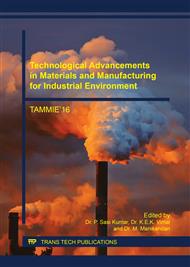p.127
p.134
p.148
p.157
p.165
p.171
p.177
p.187
p.191
Performance Evaluation of PVD and CVD Coated Inserts during End Milling with DRY and MQL Condition
Abstract:
The aim of this study were to evaluate the performance of PVD (TiAlN+TiN) and CVD (TiCN+Al2O3+TiN) coated inserts in end milling of EN–31 hardened die steel of 43±1 HRC during dry and MQL (Minimum quantity lubrication) machining. The experiments were conducted at a fixed feed rate, depth of cut and varying cutting speed to measure the effect of cutting speed on cutting force and tool wear of CVD and PVD-coated inserts. The performance of CVD and PVD-coated inserts under dry and MQL condition by measuring the tool wear and cutting force were compared. During cutting operation, it was noticed that PVD inserts provide less cutting force and tool wear as compared to the CVD inserts under both dry as well as the MQL condition because PVD inserts have a thin insert coating and CVD inserts have a thick insert coating, but PVD inserts experience catastrophic failure during cutting operation whereas CVD inserts have a capability for continuous machining under different machining. Tool wear has measured by SEM analysis. The result shows that MQL machining provides the optimum results as compared to the dry condition. MQL machining has the ability to work under high cutting speed. As the cutting speed increases the performance of dry machining was decreased, but in MQL machining, the performance of the inserts was increased with increases of cutting speed. MQL machining generates less cutting force on the cutting zone and reduces the tool wear which further increase the tool life.
Info:
Periodical:
Pages:
165-170
Citation:
Online since:
July 2017
Authors:
Price:
Сopyright:
© 2017 Trans Tech Publications Ltd. All Rights Reserved
Share:
Citation:


